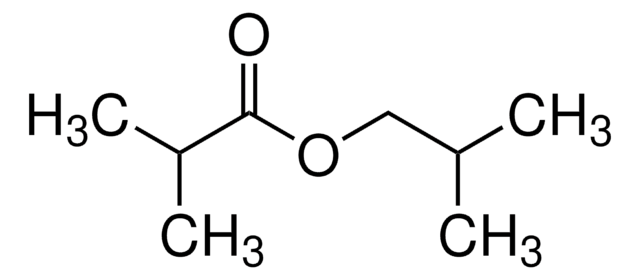W217913
Isobutyl alcohol
natural, ≥99%, FCC, FG
Sinonimo/i:
2-Methyl-1-propanol, Isobutanol, Isobutyl alcohol
About This Item
Prodotti consigliati
Grado
FG
Fragrance grade
Halal
Kosher
natural
agenzia
follows IFRA guidelines
meets purity specifications of JECFA
Conformità normativa
EU Regulation 1223/2009
EU Regulation 1334/2008 & 178/2002
FCC
FDA 21 CFR 117
Densità del vapore
2.55 (vs air)
Tensione di vapore
8 mmHg ( 20 °C)
8.8 mmHg ( 0 °C)
Saggio
≥99%
Stato
liquid
Temp. autoaccensione
801 °F
Limite di esplosione
10.6 %
Caratteristiche più verdi
Less Hazardous Chemical Syntheses
Use of Renewable Feedstocks
Learn more about the Principles of Green Chemistry.
sustainability
Greener Alternative Product
Indice di rifrazione
n20/D 1.396 (lit.)
P. ebollizione
108 °C (lit.)
108 °C
Punto di fusione
−108 °C (lit.)
Densità
0.803 g/mL at 25 °C (lit.)
applicazioni
flavors and fragrances
Documentazione
see Safety & Documentation for available documents
Allergene alimentare
no known allergens
Allergene in fragranze
no known allergens
Categoria alternativa più verde
Organolettico
ethereal; wine-like
Stringa SMILE
CC(C)CO
InChI
1S/C4H10O/c1-4(2)3-5/h4-5H,3H2,1-2H3
ZXEKIIBDNHEJCQ-UHFFFAOYSA-N
Cerchi prodotti simili? Visita Guida al confronto tra prodotti
Categorie correlate
Descrizione generale
Applicazioni
- Volatiles from nutritional fungal symbiont influence the attraction of Anisandrus maiche (Coleoptera: Curculionidae) to ethanol-baited traps.: This investigation revealed that volatiles emitted by fungal symbionts impact the attraction of Anisandrus maiche to ethanol-baited traps. The study suggests potential applications in pest management strategies by utilizing isobutanol and other volatiles (Tobin et al., 2024).
Avvertenze
Danger
Indicazioni di pericolo
Consigli di prudenza
Classi di pericolo
Eye Dam. 1 - Flam. Liq. 3 - Skin Irrit. 2 - STOT SE 3
Organi bersaglio
Central nervous system, Respiratory system
Codice della classe di stoccaggio
3 - Flammable liquids
Classe di pericolosità dell'acqua (WGK)
WGK 1
Punto d’infiammabilità (°F)
82.4 °F - closed cup
Punto d’infiammabilità (°C)
28 °C - closed cup
Dispositivi di protezione individuale
Eyeshields, Faceshields, Gloves, type ABEK (EN14387) respirator filter
Scegli una delle versioni più recenti:
Possiedi già questo prodotto?
I documenti relativi ai prodotti acquistati recentemente sono disponibili nell’Archivio dei documenti.
I clienti hanno visto anche
Global Trade Item Number
| SKU | GTIN |
|---|---|
| W217913-1KG | |
| W217913-4KG | |
| W217913-1KG-K | 4061838248916 |
| W217913-4KG-K | |
| W217913-8KG | |
| W217913-8KG-K | |
| W217913-SAMPLE | |
| W217913-SAMPLE-K | 4061838179647 |
Il team dei nostri ricercatori vanta grande esperienza in tutte le aree della ricerca quali Life Science, scienza dei materiali, sintesi chimica, cromatografia, discipline analitiche, ecc..
Contatta l'Assistenza Tecnica.










